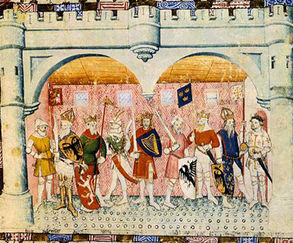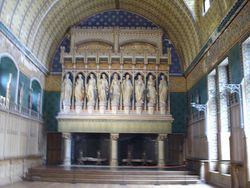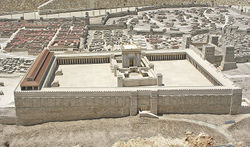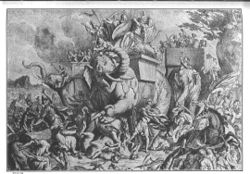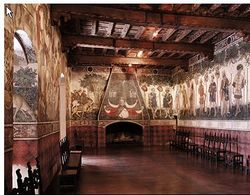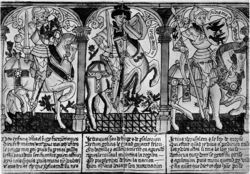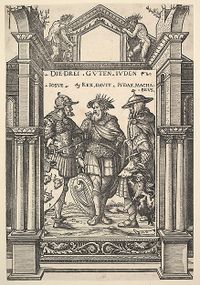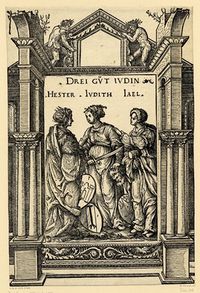Category:Nine Worthies (subject)
|
The Nine Worthies -- Overview The Nine Worthies were first described in the early 14th-century romance Voeux du Paon (1312), by Jacques de Longuyon, and referred to by Dante Alighieri in his Comedia (Paradiso 18:28-48) (c.1321). Like in the case of the association of the Sibyls with the Jewish Prophets, the medieval myth of the Nine Worthies aimed to stress the foundations of Christianity in both Judaism and the Classical World. The three triads symbolized the three principal stages of Christian providential world History. The earliest known artistic representation of the Nine Worthies is the late 14th-century carving "Neun Gute Helden" ("Nine Good Heroes") at the Altes Rathaus] in Cologne, Germany. The iconography did not distinguish them according to their relative antiquity or ethnicity, since the virtues of bravery and chivalry that they manifest were understood as timeless and universal.
In the 16th century, the Nine Worthies were represented in the engravings by Lucas van Leyden around 1525. The popularity of the Nine Worthies in Elizabethan England is attested by their many iconographic and literary representations. The Nine Worthies were mentioned by Shakespeare in two of his plays. In Love's Labour's Lost (1594) they are the protagonists of a masque that the comic characters of the play attempted to stage, with disastrous results. In Henry IV, part 2 (c.1598), Doll Tearsheet is so impressed by Falstaff's bravery in fighting Ancient Pistol that she says he is "as valorous as Hector of Troy, worth five of Agamemnon, and ten times better than the Nine Worthies." In 1598, the sculptures of the Nine Worthies spaced along the upper eastern façade on the exterior of the long gallery piers of Montacute House, South Somerset, England, and a frieze of the Nine Worthies was painted at the outset of the 17th century at North Mymms Place, Hertfordshire, an up-to-date house built by the Coningsby family, in 1599.
In 1687 Robert Burton published in England a popular literary work celebrating the lives of the Nine Worthies; see The History of the Nine Worthies of the World (1687 Burton), novel. It was the swan song of the glorious medieval tradition. The memory of the Nine Worthies faded away in modern Europe, to be revived only in neo-medieval "reconstructions," such as the statues recreated by French theorist and architect Eugène Emmanuel Viollet-le-Duc (1814-1878) at the Château de Pierrefonds in France in 1867. Among contemporary scholarly studies, the most notable is Der Topos der Nine Worthies in Literatur und bildender Kunst (The Topos of the Nine Worthies in Literature and Visual Arts / 1971 Schroeder), book. External links
The Lady Worthies -- Overview
In 1688, one year after completing his work on the Nine Worthies, Robert Burton published in England a companion book devoted to the Nine Lady Worthies, including Esther, Judith, Deborah, Susanna, and Mariamne. The memory of the Nine Lady Worthies alos faded away in modern Europe, to be revived only in neo-medieval "reconstructions," such as the Worthies Room recreated by French theorist and architect Eugène Emmanuel Viollet-le-Duc (1814-1878) at the Château de Pierrefonds in France in 1867.
|
Highlights
|
Pages in category "Nine Worthies (subject)"
The following 3 pages are in this category, out of 3 total.


